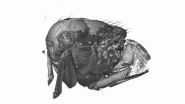(Press-News.org) A study published in Diabetologia (the journal of the European Association for the Study of Diabetes) is the first to provide direct evidence that fetal brain response to a dose of sugar given orally to its mother is associated with the mother's insulin sensitivity. This may indicate that the risk of subsequent obesity and diabetes may be pre-programmed in the womb. The study is by Dr Hubert Preissl and Dr Andreas Fritsche, University of Tübingen, Germany and German Center for Diabetes Research (DZD), Neuherberg, Germany, and colleagues.
Diabetes or obesity in the mother are already known to influence fetal development and subsequent development after birth. Children of obese or diabetic mothers have an increased risk for type 2 diabetes and obesity in adulthood, independent of their genetic background. Further to this, the prevalence of obesity and type 2 diabetes mellitus is rising worldwide and the percentage of young people affected is increasing. The reasons for these changes are unclear, although environmental and epigenetic mechanisms (where environmental factors affect genetics) are likely to be involved. A major epigenetic mechanism is the so-called fetal programming system, whereby the mother's exposure to environmental factors can affect programming of the genes in her unborn child.
In this new study, Preissl and colleagues aimed to show that the metabolism of a pregnant woman, following a meal, influences fetal brain activity. A total of 13 healthy pregnant women underwent an oral glucose tolerance test (75 g of glucose delivered orally, a standard method for determining insulin sensitivity). Insulin sensitivity was determined by glucose and insulin measurements at 0, 60 and 120 min. At each time point, the response of the fetus was examined by recording fetal brain responses elicited by sounds with a magnetoencephalographic device.
The researchers found that after 60 minutes, women who were more insulin resistant had fetuses that reacted more slowly to the sound test. When divided into two groups based on insulin sensitivity, the insulin-resistant mothers had fetuses that reacted to the sound at an average of 283 milliseconds, compared with 178 ms for the insulin-sensitive group.
They suggest that the findings support a hypothesis first made almost 50 years ago (1967) by scientist Jørgen Pedersen. The authors say: "It is possible that insulin-resistant mothers have higher glucose levels accompanied by increased insulin levels after a meal. As glucose passes the placenta, these increased glucose levels induce excess insulin (hyperinsulinaemeia) in the fetus. Therefore, high insulin levels in the mother may correspond to high insulin levels in the fetus."
They add: "It is possible that high insulin levels are a prerequisite for appropriate brain maturation. However, chronic hyperinsulinaemia, which is present in insulin-resistant mothers and corresponds to high insulin levels in the fetus, might induce insulin resistance in the fetal brain."
The authors also discuss other possible reasons for the difference in audio response times, including that the insulin resistance of the mother may be associated with limited insulin transport into the fetal brain; alternatively, the insulin resistance of the mother may be associated with a variety of other hormonal and metabolic fuel effects that control the response of the fetal brain.
The consequences for the unborn child are also spelt out, with the authors saying: "The insulin resistance of the fetal brain may be interpreted as metabolic imprinting of insulin resistance with important consequences for later life. The consequent effect of hyperinsulinaemia on fetal development has already been shown. Compared with newborns of non-diabetic women, children of diabetic mothers with poorly controlled glycaemia show neurophysiological impairment and have a higher risk for metabolic syndrome, obesity and type 2 diabetes mellitus in later life."
The authors conclude: "Lower maternal insulin sensitivity is associated with slower fetal brain responses. These findings provide the first evidence of a direct effect of maternal metabolism on fetal brain activity and suggest that central insulin resistance may be programmed during fetal development."
INFORMATION: END
Study is first to provide direct evidence that response of unborn children to glucose is associated with mother's insulin sensitivity
2014-03-26
ELSE PRESS RELEASES FROM THIS DATE:
Clean cooking fuel and improved kitchen ventilation linked to less lung disease
2014-03-25
Improving cooking fuels and kitchen ventilation is associated with better lung function and reduced chronic obstructive pulmonary disease (COPD), according to research published in this week's PLOS Medicine. The study, led by Pixin Ran from the Guanzhou Medical University, China, followed 996 villagers from southern China for 9 years to examine the effects of cleaner fuels and better kitchen ventilation on lung function and disease.
An estimated 3 billion people worldwide heat their homes and cook by burning biomass such as wood or animal dung. The resulting indoor air ...
X-rays film inside live flying insects -- in 3D
2014-03-25
VIDEO:
This video shows the insect thorax reconstructed from
tomograms and highlights the external movements of the thorax
and the location of the indirect power and steering muscles.
Click here for more information.
Scientists have used a particle accelerator to obtain high-speed 3D X-ray visualizations of the flight muscles of flies. The team from Oxford University, Imperial College, and the Paul Scherrer Institute (PSI) developed a groundbreaking new CT scanning technique ...
A way to end recurrent urinary tract infections? Study with mice gives hope
2014-03-25
(SALT LAKE CITY)—Millions of people worldwide – mostly women – suffer from recurrent urinary tract infections (UTIs) that seriously degrade their health and quality of life. Antibiotics treat individual infections, but preventing recurrent ones largely has been unattainable because of the way bacteria lodge in the inner layers of the bladder and quietly hide from drugs that can kill them.
In new studies with mice, however, researchers led by University of Utah microbiologists have shown that when chitosan, an FDA-approved compound for pharmaceutical, agricultural and ...
EEG study shows how brain infers structure, rules when learning
2014-03-25
PROVIDENCE, R.I. [Brown University] — In life, many tasks have a context that dictates the right actions, so when people learn to do something new, they'll often infer cues of context and rules. In a new study, Brown University brain scientists took advantage of that tendency to track the emergence of such rule structures in the frontal cortex — even when such structure was not necessary or even helpful to learn — and to predict from EEG readings how people would apply them to learn new tasks speedily.
Context and rule structures are everywhere. They allow an iPhone user ...
In-fly movie: 3D video from inside flying insects
2014-03-25
VIDEO:
This is a 3D movie of a blowfly's flight muscles moving created by Oxford University and Imperial scientists using a new X-ray scanning technique.
Click here for more information.
The flight muscles moving inside flies have been filmed for the first time using a new 3D X-ray scanning technique.
3D movies of the muscles were created by a team from Oxford University, Imperial College London, and the Paul Scherrer Institute (PSI), using the PSI's Swiss Light Source, ...
Strictly limiting hours surgical residents can work has not improved patient safety
2014-03-25
TORONTO, March 25, 2014--Strictly limiting the number of hours surgical residents can work has not improved patient outcomes but may have increased complications for some patients and led to higher failure rates on certification exams, a research paper concludes.
Traditionally, doctors in the residency phase of their training spent very long hours in a hospital –often around-the-clock--so they could see a wide variety and high volume of patients. In the last 10 years, health authorities started limiting those hours in the hopes of improving patient safety and the education ...
Unravelling nerve-cell death in rare children's disease
2014-03-25
LA JOLLA, Calif., March 25, 2014 — A team of scientists, led by Stuart Lipton, M.D., Ph.D., professor and director of the Neuroscience and Aging Research Center at Sanford-Burnham Medical Research Institute (Sanford-Burnham), recently discovered why cerebellar granule cell neurons in patients suffering from ataxia-telangiectasia (A-T) were unable to repair DNA damage and thus died.
A-T is a hereditary condition that begins early in childhood, and causes a gradual loss of certain nerve cells in the cerebellum of the brain. A-T occurs in about 1 in 40,000 births, with symptoms ...
Brain differences in college-aged occasional drug users
2014-03-25
Researchers at the University of California, San Diego School of Medicine have discovered impaired neuronal activity in the parts of the brain associated with anticipatory functioning among occasional 18- to 24-year-old users of stimulant drugs, such as cocaine, amphetamines and prescription drugs such as Adderall.
The brain differences, detected using functional magnetic resonance imaging (fMRI), are believed to represent an internal hard wiring that may make some people more prone to drug addiction later in life.
Among the study's main implications is the possibility ...
Penn study: Distance from designated VA liver transplant center linked with greater risk of death
2014-03-25
(PHILADELPHIA) – Veterans with liver disease who live more than 100 miles from a Veterans Administration hospital that offers liver transplants are only half as likely to be placed on the liver transplant waitlist to receive a new organ compared to veterans who live closer to transplant centers, according to a new study from the Perelman School of Medicine of the University of Pennsylvania. The findings, which are published in the March 26 issue of JAMA, also reveal that the further liver disease patients live from these five transplant centers, the more likely they are ...
Treatment helps reduce risk of esophagus disorder progressing to cancer
2014-03-25
Among patients with the condition known as Barrett esophagus, treatment of abnormal cells with radiofrequency ablation (use of heat applied through an endoscope to destroy cells) resulted in a reduced risk of this condition progressing to cancer, according to a study in the March 26 issue of JAMA.
In the last 3 decades, the incidence of esophageal cancer has increased more rapidly that other cancers in the Western world. This type of cancer often originates from Barrett esophagus, a condition that involves abnormal changes in the cells of the lower portion of the esophagus, ...



